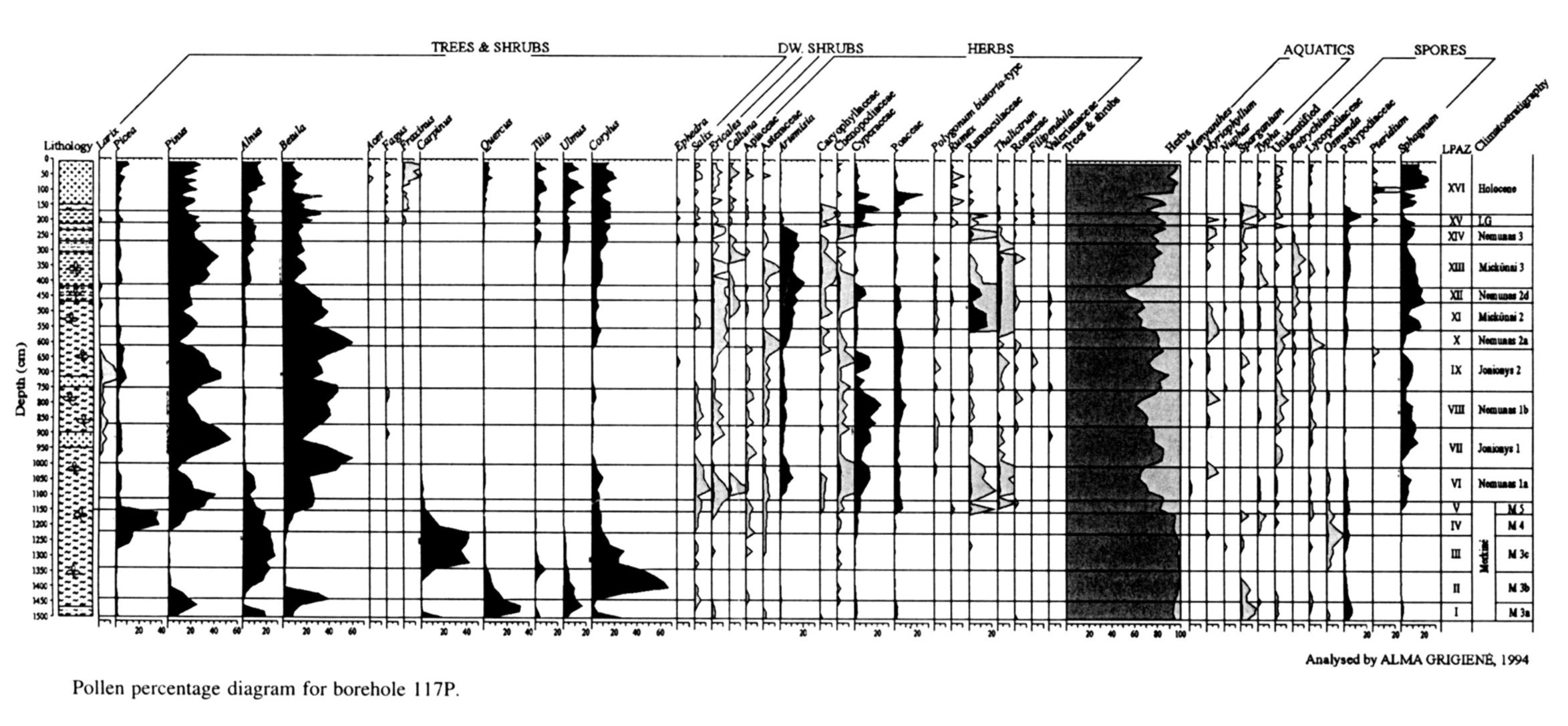Медининкай 117Р
Geological setting of the Medininkai site
The Medininkai site is located in eastern Lithuania, 30 km southeast of Vilnius, in the central part of the Medininkai highland, at 54°33’N and 25°37’E. Composed mainly of ice-pushed moraines, the Medininkai highland is a northwestern extension of the Asmena (Oshmianskaya) highland of Belarus and reaches over 300 m a.s.l. The Quaternary sequence, averaging 20-250 m in thickness, is composed of pre-Pleistocene, Lower and Middle Pleistocene tills and glaciolacustrine sediments. Merkine (Eemian) Inter-glacial deposits are distributed widely in the region and are often found in depressions in the present-day topography (Kondratiene el al. 1984, 1986; Kondratiene & VonsaviCiute 1986; Satkunas & Kondratiene 1998). Sediments of the Murava (Eemian) Interglacial, described in the adjacent region of Belarus, occur under similar conditions (Pavlovskaja & SatklTnas 1995).
Merkine Interglacial deposits in the Medininkai highland are covered by lacustrine silt and sand, gyttja and silt with organic matter, and peat, sometimes with poorly sorted silty-sand of solifluction-diluvial origin.
Lithostratigraphy
The Medininkai 117P sequence was subdivided into 19 lithostratigraphic units based on sediment colour, litho-logical composition, structure, texture and other features. The number assigned to each lithostratigraphic unit, depth in meters below the surface and lithological description are presented below:
| № | Description | Depth, m |
| 1 | Top soil. | 0.0-0.1 |
| 2 | Peat, brown, poorly humified. | 0.1-1.5 |
| 3 | Gyttja, light brown and bluish, with plant remains and peat interlayers. | 1.5-1.7 |
| 4 | Fine clayey silt, greenish-gray, minor amount of organic matter, plant remains and thin sandy interlayers. | 1.7-2.1 |
| 5 | Sandy silt, bluish-grey, microlaminated (yarved), thin interlayers of gyttja. | 2.1-2.3 |
| 6 | Fine silt, bluish-gray, massive structure. | 2.3-2.7 |
| 7 | Interbedding of massive silt and finegrained sand, gray. | 2.7-3.1 |
| 8 | Silt, bluish-gray and greenish-gray, fragments of mollusk shells and plants, a few gravel particles and interlayers of silt with organic matter. | 3.1-4.2 |
| 9 | Silt, greenish-gray, with admixture of gyttja. | 4.2-4.7 |
| 10 | Gyttja, greenish-brown, massive structure, with plant remains and from 6.1 m, wood remains and thin interlayers of black silt. | 4.7-7.2 |
| 11 | Peat, brown, highly humified. | 7.2-7.5 |
| 12 | Gyttja, dark brown-black-brown, massive, with plant remains. | 7.5-9.0 |
| 13 | Peat, brown, moderately humified, wood remains. | 9.0-9.5 |
| 14 | Gyttja, greenish-gray to brown, a few wood remains. | 9.5-11.1 |
| 15 | Gyttja, greenish-brown, horizontally laminated, with plant remains, at 12m with abundant admixture of seeds. | 11.1-13.6 |
| 16 | Gyttja, greenish-gray, massive with plant remains. | 13.6-14.7 |
| 17 | Gyttja, greenish-gray, with interlayers of sand, grading gradually to sand with organic matter. | 14.7-15.0 |
| 18 | Cobbles, pebbles, gravel. | 15.0-15.2 |
| 19 | Till, bluish-grey, massive with up to 10% gravel (diameter 2-30 mm of dolomite and limestone). | 15.2-16.0 |
The above units can be divided into 4 major groups: the uppermost peat (unit 2); a minerogenic group (units 3-9); an organogenic group (units 10-17) and a minero-genic-glacial group (units 18-19). The till underlying the organogenic sediments has been identified as being of Medininkai (Upper Saalian) age. Geological mapping indicates that it is up to 100m thick (Satkunas 1997). A stone pavement of cobbles, pebbles and gravel (unit 18) occurs on top of the till, showing that erosional processes, probably related to meltwater, were active before the formation of the kettlehole.
Pollen stratigraphy
Pollen grains are generally well preserved in the analyzed samples. At some levels they are corroded, which suggests redeposition (e.g. those of broad-leaved trees in the interval dominated by silty layers between 6.0 and 1.5 m depth). The frequencies of arboreal pollen are markedly high throughout the whole sequence, except for the interval between 3.70 and 2.85 m depth. Pollen analysis has allowed 16 (I-XVI) local pollen assemblage zones (LPAZ) to be identified:
Zone I (15.0-14.4 m). Quercus-Ulmus LPAZ: Quercus and Ulmus predominate. Betula and Pinus are also present in high numbers.
Zone II (14.4-13.4 m). Corylus LPAZ: Corylus pollen shows a clear maximum forming up to 70% of the total. Tilia (10%) appears as Corylus decreases.
Zone III (13.4-12.2 m). Carpinus-Alnus LPAZ: Carpinus pollen increases and reaches up to 40% of the pollen total. Alnus is also represented by high frequencies. Spores of Osmunda were noted in this zone.
Zone IV (12.2-11.5m). Picea LPAZ: This zone is characterized by a sharp rise in the Picea curve. Some Picea pollen grains were identified as Picea omorica-type. Alnus is present, making up 20% of the total. Some samples in this zone also contain spores of Osmunda, accounting for up to 2%.
Zone V (11.5-11.1 m). Pinus-Betula-Poaceae
LPAZ: The relative amounts of Pinus (up to 40%) and Betula (up to 30%) rise in this
zone. The percentage values of Poaceae. Cyperaceae and Ericales also increase.
Zone VI (11.1-10.0 m). Betula-Cyperaceae-Artemi-s/a-Ericales LPAZ: Betula pollen increases up to 50% in the upper part of this zone. The proportion of herbaceous pollen is high, e.g. Cyperaceae (15%), Artemisia (10%) and Poaceae (5%). Ericales rises to 3%. Pollen of Corylus, QM, Alnus and Picea are reworked from older sediments. Sphagnum spores are present at the 10% level. Part of zones V and VI is a transitional interglacial/ glacial phase, as indicated by the spread of Ericales (Behre 1989).
Zone VII (10.0-8.7 m). Betula-Pinus LPAZ: Betula (60%) prevails in the lower part of the zone while in the upper part Betula is replaced by Pinus, which gradually increases to 55%.
Zone VIII (8.7-7.5 m). Betula-Cyperaceae LPAZ: This zone shows high values of Betula pollen. Cyperaceae reaches 25%, and Artemisia and Poaceae are also present.
Zone IX (7.5-6.1 m). Pinus-Picea-Larix LPAZ: Pollen from coniferous trees dominate: Pinus (45%), Picea (7%), Larix (3%). Betula accounts for 30%. The percentage values of herbaceous pollen are still high with Cyperaceae at 15% and Poaceae at 5%.
Zone X (6.1-5.5m). Betula-Artemisia-Poaceae LPAZ: Betula reaches high values, and pollen from herbs, mostly Artemisia and Poaceae, constitutes 20% of the pollen sum.
Zone XI (5.5-4.6 m). Betula-Artemisia-Ranunculaceae: This zone is marked by a decrease in tree pollen and a coincident increase in herbaceous pollen. Artemisia (10%) and Ranunculaceae (15%) predominate. The Ranunculaceae pollen probably represent the Batrachium-type, since a large number of fruits of this genus were found (cf. Table 1). A minor increase in Calluna and Thalic-trum is noted. A few pollen grains of aquatic plants appear in the zone.
Zone XII (4.6-4.1 m). NAP LPAZ: NAP accounts for 50% of the total pollen sum. Artemisia, Cyperaceae, Poaceae, Ranunculaceae dominate. Pollen of aquatic plants disappear.
Zone XIII (4.1-2.7m). Pinus-Artemisia LPAZ: This zone is dominated by Pinus and Artemisia pollen. Cyperaceae and Caryophyllaceae are common herbs. The presence of a few Botrychium spores is noteworthy. Redeposi-ted pollen occur (Alnus, Corylus).
Zone XIV (2.7-2.1 m). Betula-Artemisia LPAZ: Tree pollen constitutes 80-90% of the pollen sum. Pollen of Artemisia, Chenopodiaceae, Ranunculaceae, Rosaceae represent herbs. A few pollen grains of the shrub Ephedra
were also identified. The values of herbaceous pollen would be considerably higher if redeposited pollen were excluded, i.e. of thermophilous trees and Pinus, the pollen of which is considered to have been transported over a long distance.
Zone XV (2.1-1.7m). Betula- Cyperaceae-Artemisia LPAZ: Betula and Pinus are dominant among the arboreal pollen. A small peak (up to 5%) of Picea is noted. Herb pollen is dominated by Cyperaceae, Artemisia and Poaceae (in the upper part of the zone).
Zone XVI (1.7-0.0 m). Quercetum mixtum LPAZ: After the spread of Betula and Pinus, trees such as Ulmus, Tilia, Fraxinus, Quercus, Corylus, Alnus and Picea migrated in. In this zone herbs are represented mainly by Poaceae and Cyperaceae.
Plant macrofossils
Eight assemblages of plant macrofossils have been distinguished, suggesting that the sediments accumulated during eight different stages of the palaeolake. The macrofossils identified in samples 51-40, from the interval 15.0-1 l.lm, are characteristic of the Eemian Interglacial flora, e.g. Pinus sylvestris, Picea sect. Picea, Alnus glutinosa, Carpinus betulus, Corylus cf. avellana, Tilia sp., Viburnum cf. Ian tana, Salvinia natans, Sparganium microcarpum, Nym-phaea alba, Nuphar lutea, Trapa sp., Najas marina, Caulinia flexilis and Pilea lithuanica Risk. Pilea lithuanica Risk, is an extinct species first defined and described by Riskiene (1978). The species is characteristic of the Eemian Interglacial climatic optimum. According to maerofossil data, the boundary between the Eemian Interglacial and the Weich-selian glaciation is marked by the disappearance of certain species, e.g. Najas marina, Carpinus betulus, Nymphaea alba and Nuphar lutea. A sharp increase in Batrachium sp., indicates water level increases in the basin.
Between 11.1 and 10.0m (samples 39-34), plant remains show a cryomer flora: Betula sect. Albae is replaced by Betula nana. Macrofossils of Selaginella selaginoides, Potamogeton alpinus, P. dorofeevii and P. filiformis were identified. Abundant remains of Characeae, Batrachium, Isoetes lacustris and Potamogeton praelongus indicate a high water level in the lake. .
In samples 33-28 (10.0-8.7 m), Larix decidua Mill., and Betula sect. Albae dominate among the tree species. Pinus and Picea are poorly represented in this interval. Remains of aquatic plants such as Menyanthes trifo-liata, Potamogeton friesii, P. rutilus, P. pussilus, P. compressus, P. perfoliatus, P. natans and different Carex indicate a climatic amelioration, most probably
corresponding to the Jonionys 1 thermomer (the Brorup interstadial). The abundance of moss remains and the typical swamp species Comarum palustre, along with the absence of aquatic plants (e.g. Potamogeton praelongus), indicate that the Medininkai palaeolake had become a bog.
Few macrofossils were identified in samples 27-25 (8.7-7.5 m), suggesting climatic deterioration. There are very few remains of Larix and B. sect. Albae. B. humilis, Selaginella selaginoides and Potamogeton filiformis are common. Corroded seeds suggest that some plant material is derived from older deposits.
The plant maerofossil assemblages of samples 24-19 (7.5-6.1 m) indicate favourable climatic conditions and suggest correlation of this interval with the thermomer Jonionys 2 (Odderade interstadial). A large number of genera (38 taxa) was noted. Among trees, Larix and Betula sect. Albae dominate, and Pinus sylvestris and Picea sect. Picea are present. Several Potamogeton species (P. natans, P. obtusifolius, P. compressus, P. sukaczevii) were identified in this interval. Potamogeton sukaczevii, noted only in this interval, has been described as a typical species of the last interglacial and Brorup interstadial in Belarus, Lithuania, Russia and Poland (Velichkevich & Grano-szewski 1996). Plant remains that are not thermophilic, but are common in interglacial flora (Ceratophyllum demersum, Eleocharis ovata, Rubus idaeus, Rorippa palustris and Lycopus europaeus), were found. The flora of this interval appears to be more thermophilic than that of the Brorup complex. A flora of similar composition was noted in Poland (Mamakowa 1989).
The composition of the maerofossil flora in samples 18-16 (6.1-5.5 m) shows changes in the vegetation cover and cryomer climatic conditions. The assemblage is dominated by the remains of herbs and mosses, including Characeae and Batrachium. Megaspores of Selaginella selaginoides were found in large quantities. Conifer macrofossils are absent; only a few needle fragments of Larix were identified. The scarce remains of Betula sect. Albae and B. humilis, which most probably represent shrubs, were noted.
The macrofossils identified in samples 15-13 (5.4-4.7 m) include Isoetes lacustris, Pinus sylvestris, Potamogeton perfoliatus, Alisma-plantago-aquatica, Nauburgia thyrsiflora, Betula humilis and Carex spp. This assemblage indicates a slight climatic amelioration that correlates with the Hengelo interstadial. The change to periglacial conditions is marked by sample 12 (4.7-4.5 m), in which an assemblage including Selaginella selaginoides, S. tetraedra, Salix polaris, Potentilla nivea, Ranunculus gmelini and Potamogeton dorofeevii was identified.
The uppermost part of the sequence 117P is poor in macrofossils, and consequently no conclusions could be drawn about the composition of the flora in this part of the succession.
Satkunas J., Grigiene A., Velichkevich F., Robertsson, A.-M., Sandgren P. Upper Pleistocene stratigraphy at the Medininkai site, eastern Lithuania:a continuous record of the Eemian-Weichselian sequence // Boreas. №32. 2003. Pp. 627-641.

